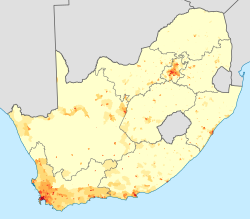Our website is made possible by displaying online advertisements to our visitors.
Please consider supporting us by disabling your ad blocker.
Coloureds
 An extended Coloured family with roots in Cape Town, Kimberley and Pretoria | |
| Total population | |
|---|---|
| 5,600,000~ in southern Africa | |
| Regions with significant populations | |
| South Africa, Namibia, Botswana, Zimbabwe | |
| 5,052,349 (2022 census)[1] | |
| 107,855 (2023 census)[2][a] | |
| 14,130 (2022 census)[3] | |
| 3,000 (2012 census)[4] | |
| Languages | |
| Afrikaans, English, IsiXhosa, Setswana[5] | |
| Religion | |
| Predominantly Christianity, minority Islam | |
| Related ethnic groups | |
| Africans, Mulatto, White South Africans, Afrikaners, Boers, Cape Dutch, Cape Coloureds, Cape Malays, Griquas, San people, Khoikhoi, Zulu, Xhosa, Saint Helenians, Rehoboth Basters, Tswana | |

- 0–20%
- 20–40%
- 40–60%
- 60–80%
- 80–100%

- <1 /km2
- 1–3 /km2
- 3–10 /km2
- 10–30 /km2
- 30–100 /km2
- 100–300 /km2
- 300–1000 /km2
- 1000–3000 /km2
- >3000 /km2
Coloureds (Afrikaans: Kleurlinge) are multiracial people in South Africa, Namibia and to a lesser extent, Zimbabwe and Zambia. Their ancestry descends from the interracial marriages/interracial unions that occurred between Europeans, Africans and Asians.[6] Interracial mixing in South Africa began in the Dutch Cape Colony in the 17th century when the Dutch men mixed with Khoi Khoi women, Bantu women and Asian female slaves and mixed race children were conceived.[6] Eventually, interracial mixing occurred throughout South Africa and the rest of Southern Africa with various other European nationals such as the Portuguese, British, Germans, and Irish, who mixed with other African tribes which contributed to the growing number of mixed-race people, who would later be officially classified as Coloured by the apartheid government.[7][8][9]
Coloured was a legally defined racial classification during apartheid referring to anyone not white or of the black Bantu tribes, which effectively largely meant people of colour.[9][10]
The majority of coloureds are found in the Western Cape, but are prevalent throughout the country. According to the 2022 South African census, Coloureds represent 8.15% of people within South Africa, while they make up 42.1% of the population in the Western Cape and 41.6% in the Northern Cape, representing a plurality of the population in these two provinces of South Africa.[11] In the Western Cape, a distinctive Cape Coloured and affiliated Cape Malay culture developed. Genetic studies suggest the group has the highest levels of mixed ancestry in the world.
The apartheid-era Population Registration Act, 1950 and subsequent amendments, codified the Coloured identity and defined its subgroups, including Cape Coloureds and Malays. Indian South Africans were initially classified under the act as a subgroup of Coloured.[12] As a consequence of Apartheid policies and despite the abolition of the Population Registration Act in 1991, Coloureds are regarded as one of four race groups in South Africa. These groups (blacks, whites, Coloureds and Indians) still tend to have strong racial identities and to classify themselves and others as members of these race groups.[10][9] The classification continues to persist in government policy, to an extent, as a result of attempts at redress such as Black Economic Empowerment and Employment Equity.[9][13][14]
- ^ "Census 2022 Statistical Release" (PDF). Statistics South Africa. Retrieved 1 November 2024.
- ^ "Namibia 2023 Population and Housing Census Main Report" (PDF). Namibia Statistics Agency. Retrieved 30 October 2024.
- ^ "Zimbabwe 2022 Population and Housing Census Report, vol. 1" (PDF). ZimStat. Zimbabwe National Statistics Agency. p. 122. Archived from the original (PDF) on 1 October 2024.
- ^ Milner-Thornton, Juliette Bridgette (2012). The Long Shadow of the British Empire: The Ongoing Legacies of Race and Class in Zambia. Palgrave Macmillan. pp. 9–15. ISBN 978-1-349-34284-6.[permanent dead link]
- ^ Alexander, Mary (9 June 2019). "What languages do black, coloured, Indian and white South Africans speak?". South Africa Gateway. Retrieved 15 June 2024.
- ^ a b "Coloured | Meaning, Identity, Discrimination & History | Britannica".
- ^ "The Coloured Communities of Southern Africa, a story".
- ^ "coloured". Oxford Dictionaries. Oxford University. Archived from the original on 9 March 2014. Retrieved 14 April 2014.
- ^ a b c d Posel, Deborah (2001). "What's in a name? Racial categorisations under apartheid and their afterlife" (PDF). Transformation: 50–74. ISSN 0258-7696. Archived from the original (PDF) on 8 November 2006.
- ^ a b Pillay, Kathryn (2019). "Indian Identity in South Africa". The Palgrave Handbook of Ethnicity. pp. 77–92. doi:10.1007/978-981-13-2898-5_9. ISBN 978-981-13-2897-8.
- ^ https://census.statssa.gov.za/assets/documents/2022/P03014_Census_2022_Statistical_Release.pdf
- ^ "1950. Population Registration Act No 30 - the O'Malley Archives".
- ^ "Manyi: 'Over-supply' of coloureds in Western Cape". 24 February 2011.
- ^ "BBC News - How race still colours South African elections". BBC News. 20 April 2011. Archived from the original on 20 November 2014.
Cite error: There are <ref group=lower-alpha> tags or {{efn}} templates on this page, but the references will not show without a {{reflist|group=lower-alpha}} template or {{notelist}} template (see the help page).
Previous Page Next Page


